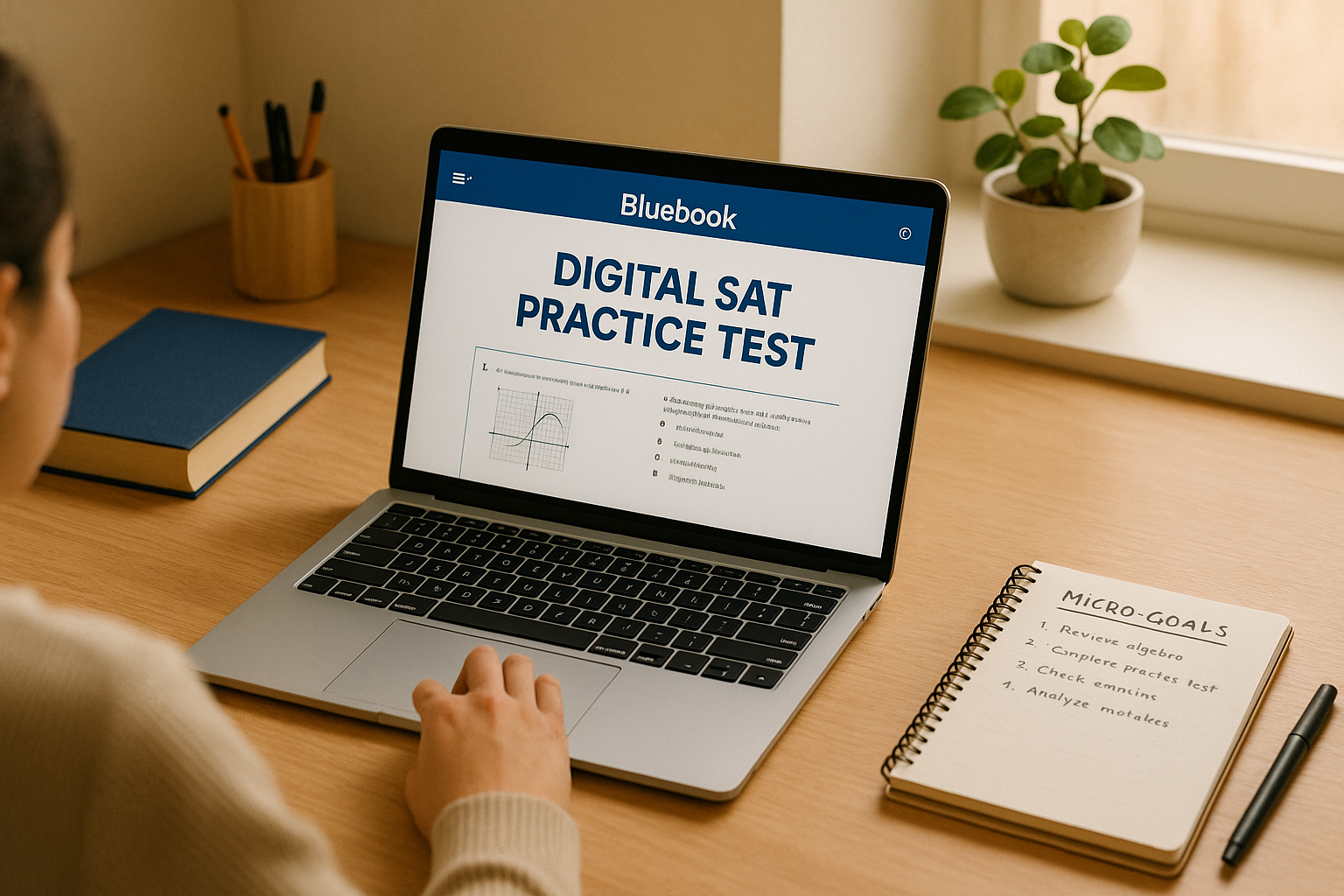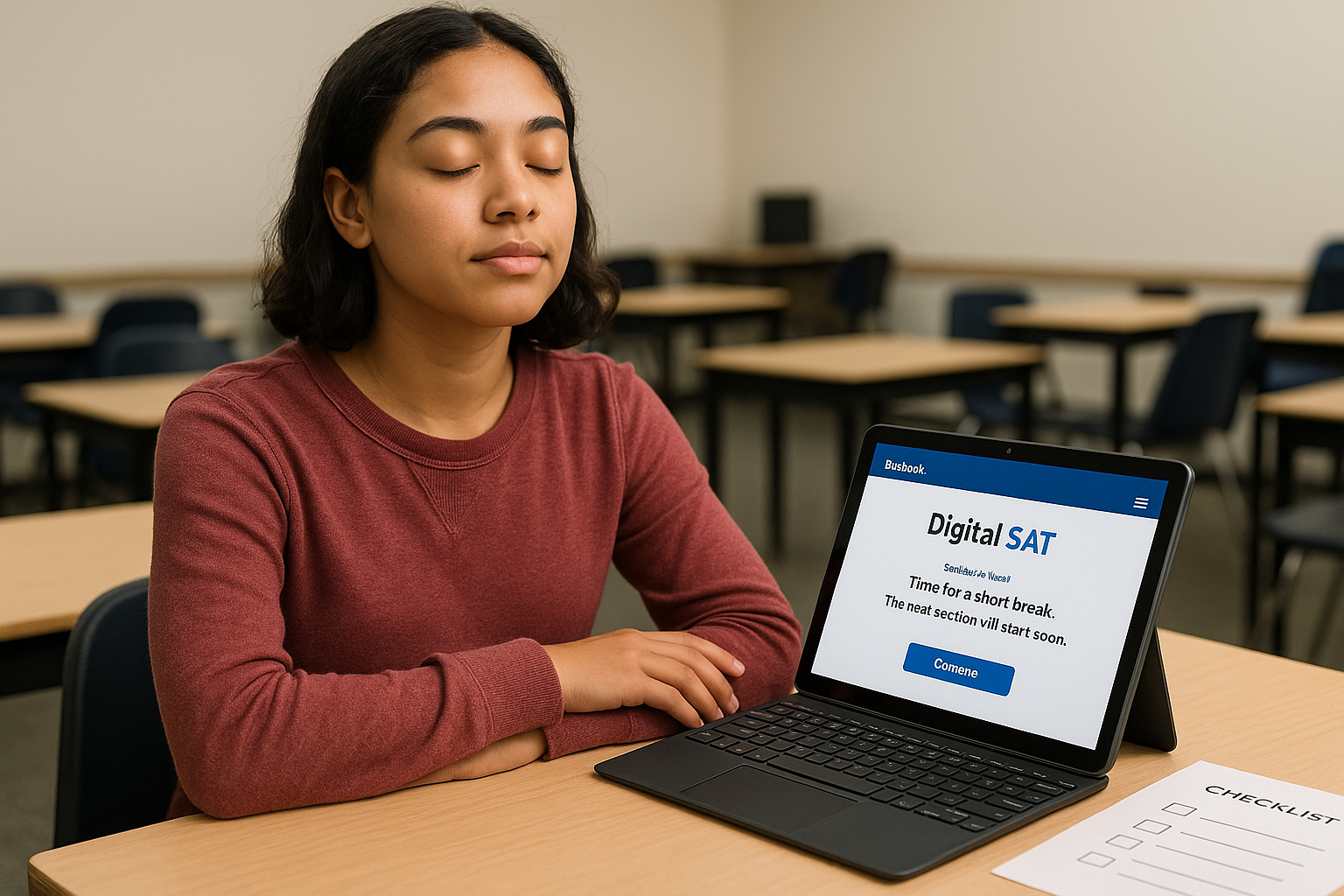Introduction: More Than Practice — The Quiet Power of Belief
When you picture the SAT, you probably think of practice tests, formulas, and timed sections. Those things matter — a lot. But there’s another ingredient that quietly shapes every single practice session and test-day decision: self-belief. This isn’t fluffy motivation or empty pep talk. It’s a measurable, trainable mindset that influences how you study, how you respond under pressure, and how you translate your preparation into performance.
If you’re preparing for the digital SAT, the test’s format, timing, and tools will influence your tactics. Still, the mental game — how much you trust your preparation and ability — often makes the difference between a practice score and a real improvement. This post is written for students like you who want actionable ways to build belief, make it stick, and turn it into a higher SAT score.
Why Self-Belief Matters for SAT Performance
Believing you can improve does more than make you feel good. It changes your brain and behavior. Students who expect to grow:
- Persist longer through difficult practice problems instead of giving up.
- Learn from mistakes — they see errors as data rather than proof of fixed inability.
- Choose effective strategies like targeted practice and active review.
- Manage test anxiety better, which reduces careless errors on test day.
In short: belief shapes the decisions you make while studying and the responses you give under pressure. Without that belief, even excellent study materials can be underused.
How Belief and Preparation Interact
Think of preparation and belief as two legs of a ladder. One leg is skills and knowledge (content mastery, test strategies, timed practice). The other leg is belief (confidence, resilience, expectancies). If either leg is weak, the ladder wobbles.
Practical example: two students study the same number of hours. One expects improvement and treats mistakes as stepping stones; the other interprets mistakes as proof they’re “not a test person.” The first student adapts study methods, seeks targeted help, and typically sees better results.
Real-World Context: Digital SAT Differences and Mindset
The Digital SAT introduces features like adaptive sections, the Bluebook testing app for practice, and built-in tools (e.g., a calculator in many places). These changes make technical practice essential, but they don’t replace the need for psychological readiness. On test day, a calm, confident student who has practiced in the digital environment will out-perform a panicked, over-prepared student who doubts themselves.
Signs Your Self-Belief Might Be Holding You Back
It’s not always obvious when belief is the weak link. Watch for these patterns:
- Avoiding full-length digital practice tests because you’re afraid of a low score.
- Fixating on a single past bad practice score and using it to predict future failure.
- Setting goals that are either too timid (safe) or unrealistically high without a plan.
- Relying heavily on last-minute cramming rather than steady, targeted practice.
If any of these sound familiar, the good news is that belief is trainable — and there are concrete steps to rebuild it.
Practical Steps to Build Lasting Self-Belief
Here’s a step-by-step framework that blends mindset work with practical SAT preparation. Follow it consistently and you’ll see the payoff in both confidence and scores.
1. Reframe Mistakes as Feedback
Every missed question is a clue about what to practice next. After a practice test, don’t just record the score — categorize errors:
- Content gap (you don’t know the concept)
- Strategy error (you used the wrong approach)
- Execution error (time pressure, misreading)
Make a short action plan for each error type — that action plan is your proof that progress is possible.
2. Use Micro-Goals to Create a Sense of Progress
Big goals (like “get 1400”) are motivating, but micro-goals give frequent wins. Examples:
- Mastering the concept of function transformations in one week.
- Cutting average time on grid-in math problems by 20 seconds over two weeks.
- Completing two adaptive Bluebook practice sections per week.
Micro-goals provide constant evidence that you’re improving, which builds belief.
3. Practice in the Same Digital Environment
Familiarity reduces uncertainty. Use the official Bluebook practice app and take full-length adaptive practice tests. Simulate test conditions: same device, lighting, timing, and break patterns. The more routine the testing situation feels, the less room there is for doubt on test day.
4. Use Evidence-Based Reflection
After a test or study session, spend 10 minutes on focused reflection:
- What I did well (be specific)
- What I struggled with (categorize: content/strategy/execution)
- One concrete step for the next session
Keep a short journal. Over time you’ll accumulate a record of progress — the best antidote to self-doubt.
5. Strengthen Resilience With Short Challenges
Deliberately choose practice tasks that are just outside your comfort zone. These “stretch” tasks teach you that struggle doesn’t mean failure — it means growth. Celebrate the attempt as much as the outcome.
How Study Structure and Environment Support Belief
Self-belief grows faster when your study routine is predictable and effective. Below is a simple weekly structure you can adapt.
| Day | Focus | Time | Why it Builds Belief |
|---|---|---|---|
| Monday | Content review (math or reading skill) | 60–90 min | Mastery increases confidence |
| Tuesday | Targeted problem sets | 45–60 min | Practice under slight pressure |
| Wednesday | Timed practice section (Bluebook) | 60 min | Builds digital test familiarity |
| Thursday | Error analysis & review | 45–60 min | Turn mistakes into actionable plans |
| Friday | Mixed practice + strategy | 60 min | Reinforces adaptability |
| Saturday | Full-length adaptive practice or targeted mock | 2–3 hours | Simulates test day and measures progress |
| Sunday | Rest, light review, reflection | 30–45 min | Prevents burnout and consolidates gains |
Mindset Techniques That Actually Work
Here are research-backed mindset techniques you can practice daily to strengthen confidence.
Visualization — Practice the Process, Not Just the Outcome
Instead of only imagining the final score, visualize specific moments during a test: reading a passage calmly, choosing a quick strategy for a math problem, recovering after a tough question. Process visualization rehearses behavior; that rehearsal builds trust in your ability to execute.
Self-Talk — What You Say Matters
Replace global negative statements (“I’m terrible at tests”) with specific, actionable truths (“I struggled with timing on grid-in questions, and I’ll practice three timed sets this week”). Specific statements are credible and fixable; they build belief rather than erode it.
Incremental Evidence — Keep a Progress File
Collect evidence of growth: improved timed-section scores, fewer careless errors, faster pacing. When you doubt yourself, review the file. Tangible proof is the most persuasive confidence booster.
When to Ask for Help — and How to Choose Support
Asking for help is not a failure; it’s a strategic choice. If you find yourself stuck in a cycle of repeating mistakes, losing motivation, or getting anxious on full-length tests, external support can accelerate progress and rebuild belief.
High-quality support should include:
- Individualized diagnosis of strengths and weaknesses
- A tailored study plan with measurable milestones
- Coaching for both strategy and mindset
- Regular feedback and adjustments based on practice data
Sparkl’s personalized tutoring offers many of these benefits: 1-on-1 guidance, tailored study plans, expert tutors, and AI-driven insights that help focus practice on what truly matters. When used alongside your own disciplined work, such support can be a powerful confidence builder.
Examples: Students Who Rewrote Their Stories
Stories help make the abstract real. Here are two anonymized, composite examples based on common patterns I’ve seen.
Case Study A — The Underconfident Over-Achiever
Background: A student with strong class grades but fear of standardized tests avoided full-length practice. Early timed tests showed variable results and low confidence.
Strategy: They set micro-goals, practiced in Bluebook weekly, and kept a progress file documenting improvements. They used process visualization before each timed section and reframed mistakes as diagnostics.
Outcome: After eight weeks, full-length scores stabilized and increased. The student reported less test anxiety and more control during sections they previously dreaded.
Case Study B — The Stuck Student
Background: Another student hit a plateau on math. They reviewed content but didn’t change study structure and blamed innate ability.
Strategy: They worked with a tutor who diagnosed a consistent strategy error on rate and mixture problems. The tutor provided targeted drills, timed practice, and mindset coaching to treat mistakes as fixable. Small wins were celebrated publicly in sessions.
Outcome: Conceptual clarity combined with repeated practice led to steady score gains. The student’s belief in their ability to improve improved dramatically, and they could approach new problem types with curiosity rather than dread.
Test Day: Putting Belief Into Action
On the Digital SAT, belief shows up as steady breathing, clear thinking, and recoveries from setbacks. Use these practical test-day strategies to let your preparation — and your belief — shine.
- Warm up with a short, focused review rather than cramming. Review one or two problems you solved well in practice to prime success.
- Use a breathing or centering routine between sections: 4 seconds in, hold 2, 6 seconds out. It resets attention.
- When you face a tough question, use a micro-decision rule: allocate X seconds; if no progress, mark and move on. Trust your ability to return calmly later.
- Keep a brief, positive anchor phrase in your pocket (e.g., “Plan, try, learn”). Use it when doubt creeps in.

Measuring Progress Without Letting Scores Define You
Numbers matter, but they’re one indicator among many. Measure progress using multiple lenses:
- Score trends across adaptive practice tests (not just one-off scores)
- Reduction in specific error types
- Consistency in timing and pacing
- Emotional markers — less anxiety, more expectation of improvement
Set regular check-ins (every two weeks or monthly) to evaluate both hard data and softer signals. When both improve, you’ve built reliable belief — the kind that survives pressure.
Quick Tools and Exercises to Build Belief (Daily and Weekly)
Here are simple, time-efficient exercises you can integrate into a busy schedule. Do one daily and one weekly item.
- Daily: 5-minute reflection — write one specific success from your practice and one tiny improvement goal.
- Daily: 3-minute visualization before practice — imagine executing strategy steps calmly.
- Weekly: One full-length adaptive Bluebook practice test under test-like conditions.
- Weekly: Share a small win with a coach, tutor, or study partner — social recognition reinforces belief.
Common Belief Pitfalls and How to Avoid Them
Even motivated students fall into traps. Here’s how to notice and counter the most common ones.
- Perfectionism: Attack it by setting “good enough” checkpoints (e.g., complete 80% of a timed section and review the rest).
- Comparison: Focus on your progress file. Other students’ journeys don’t predict yours.
- All-or-nothing thinking: If you miss a target, ask “what did I learn?” rather than “I failed.”
How Tutoring Can Multiply the Effects of Self-Belief
Personalized tutoring amplifies belief when it’s done right. A good tutor does more than teach content — they diagnose, design targeted practice, provide timely feedback, and coach mindset. That combination accelerates progress and builds a convincing record of improvement, which in turn strengthens belief.
Sparkl’s personalized tutoring model — with 1-on-1 guidance, tailored study plans, expert tutors, and AI-driven insights — is designed to create that feedback loop: targeted practice leads to small wins, small wins build belief, and belief fuels better practice. When coaching feels bespoke to your needs, it becomes easier to trust the process.
Final Thoughts: Start Small, Keep Going
Self-belief isn’t an instant download. It’s a practice, just like math problems or command of grammar. It grows from consistent, intentional actions: practicing in the digital environment, turning mistakes into plans, collecting evidence of improvement, and asking for help when needed.
When you approach the Digital SAT with a plan and the quiet conviction that effort will pay off, the test stops being a verdict on who you are and becomes a measure of what you’ve worked to accomplish. That shift — from fear to agency — is the clearest path to a better score and a less stressful test day.
Takeaways — Your Belief Checklist
- Practice in the Bluebook environment to reduce uncertainty.
- Keep a progress file that shows improvements, however small.
- Use micro-goals and celebrate small wins.
- Transform mistakes into targeted action plans.
- Consider individualized support if plateaus persist — tutoring can accelerate both skill and belief.
Remember: belief doesn’t magically replace study; it makes your study work smarter. Combine consistent, structured practice with these mindset strategies, and you’ll not only see your scores rise — you’ll also go into test day with calm, steady confidence. You’ve got the skills; now build the belief to use them.
Want a Starting Plan?
If you want a simple, 6-week starter plan tailored to your current level and goals — including small mindset exercises and adaptive practice schedules — try building one today. If personalized guidance feels right, tutoring that pairs targeted strategy with mindset coaching (like Sparkl’s model) can turn that starter plan into measurable momentum.
Good luck — and remember: every small step forward is proof you’re capable of more than you think. Believe it, practice it, and watch what happens.














No Comments
Leave a comment Cancel